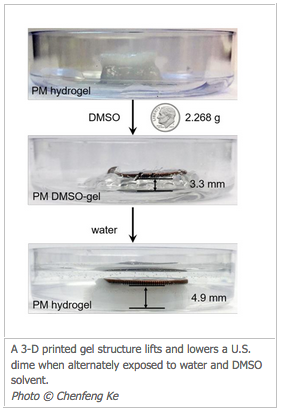By Warren Miller, contributing writer
Nano-machines are ultra-tiny mechanical devices fabricated by assembling one atom at a time. These machines have a very wide applicability for operating at the molecular level — attacking diseases, removing pollutants from water, and even building other tiny machines or replicating themselves — the possibilities are mind-boggling. Until recently, however, nano-machines only operated at the microscopic level. Now researchers have developed a way of making them produce results that we can see with the naked eye.
Nano-machines operate on other tiny, molecular objects, and their activities can be observed using a powerful microscope. Getting nano-machines to do something at a human scale, something one could actually see directly, however, was not possible. That’s because nano-machines were difficult to arrange in such a way as to allow for organized effort. The devices were randomly aligned in the normal state, working against each other — kind of like a group of rowers in a boat who are all pulling in different directions. Needless to say, this makes it difficult to get where you’re going.
Now, researchers at Dartmouth College have found a way to overcome this limitation in nano-machine applications. By using an innovative 3D-printing technique, they’re able to organize nano-scale devices to work together, cooperatively, to achieve human-scale results. The 3D-printing approach allows the nano-devices to be aligned by the printing process. The nano-devices can be set to row in the same direction; this allows for cooperation between massive numbers of devices, and when you get enough nano-devices working together, you can see the results at the macro-scale.
The researchers demonstrated a macro-scale operation by 3D-printing a special gel made of nano-devices. The nano-devices have a special molecular structure, composed of rings on an axle, on a molecular scale. The rings can move along the axle, and by doing so, alter their shape to store or release energy. The mechanically interlocked molecules — or MIMs — have previously been used at the molecular level as microscopic pumps and switches, but the normal random orientation has kept them from cooperating on the scale needed to generate macro-level work.
The nano-devices in this special gel can be activated by first adding a dimethyl sulfide (DMSO) solvent to store energy; water is then added to release the stored energy. The nano-molecules respond by expanding and, in the demonstration, lifting a dime 1.6 mm. The coin weighs 15 times the gel, for a 15-to-1 lift ratio. Pretty impressive, but not quite the 50 to 100 times its weight that an ant can lift. (Ants have had much longer to perfect their weight-lifting skills, however.) Over time, I’m sure the nano-devices will evolve to be able to successfully arm-wrestle an ant, and maybe even a human being.

Image source: Dartmouth College.
This research opens up a wide range of possible applications at the macro-level, robotics being the most intriguing to me. Could these types of nano-machines be used to create the equivalent of limbs, hands, and feet? Or would macro-level movement be better implemented as an articulated sphere, or with millions of small, root-like legs? Would we even be able to see how the robot moves or grasps things, or would it look like a cloud of ultra-thin wires moving in unison? Perhaps nano-devices will even adapt quickly to the environment and select a movement method that best fits the situation. The door is open now, and whatever comes through it will likely surprise you.
Advertisement
Learn more about Electronic Products Magazine





